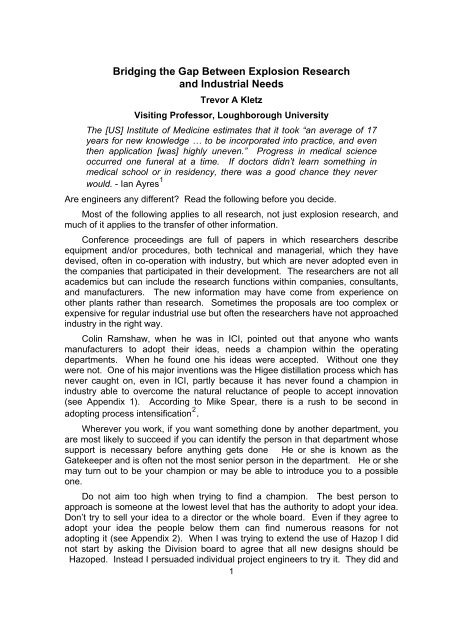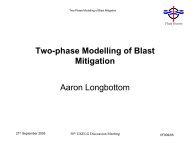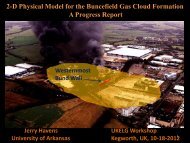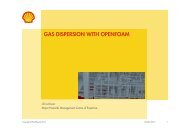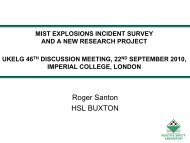Create successful ePaper yourself
Turn your PDF publications into a flip-book with our unique Google optimized e-Paper software.
Bridging the Gap Between Explosion Research<br />
and Industrial Needs<br />
<strong>Trevor</strong> A <strong>Kletz</strong><br />
Visiting Professor, Loughborough University<br />
The [US] Institute of Medicine estimates that it took “an average of 17<br />
years for new knowledge … to be incorporated into practice, and even<br />
then application [was] highly uneven.” Progress in medical science<br />
occurred one funeral at a time. If doctors didn’t learn something in<br />
medical school or in residency, there was a good chance they never<br />
would. - Ian Ayres 1<br />
Are engineers any different? Read the following before you decide.<br />
Most of the following applies to all research, not just explosion research, and<br />
much of it applies to the transfer of other information.<br />
Conference proceedings are full of papers in which researchers describe<br />
equipment and/or procedures, both technical and managerial, which they have<br />
devised, often in co-operation with industry, but which are never adopted even in<br />
the companies that participated in their development. The researchers are not all<br />
academics but can include the research functions within companies, consultants,<br />
and manufacturers. The new information may have come from experience on<br />
other plants rather than research. Sometimes the proposals are too complex or<br />
expensive for regular industrial use but often the researchers have not approached<br />
industry in the right way.<br />
Colin Ramshaw, when he was in ICI, pointed out that anyone who wants<br />
manufacturers to adopt their ideas, needs a champion within the operating<br />
departments. When he found one his ideas were accepted. Without one they<br />
were not. One of his major inventions was the Higee distillation process which has<br />
never caught on, even in ICI, partly because it has never found a champion in<br />
industry able to overcome the natural reluctance of people to accept innovation<br />
(see Appendix 1). According to Mike Spear, there is a rush to be second in<br />
adopting process intensification 2 .<br />
Wherever you work, if you want something done by another department, you<br />
are most likely to succeed if you can identify the person in that department whose<br />
support is necessary before anything gets done He or she is known as the<br />
Gatekeeper and is often not the most senior person in the department. He or she<br />
may turn out to be your champion or may be able to introduce you to a possible<br />
one.<br />
Do not aim too high when trying to find a champion. The best person to<br />
approach is someone at the lowest level that has the authority to adopt your idea.<br />
Don’t try to sell your idea to a director or the whole board. Even if they agree to<br />
adopt your idea the people below them can find numerous reasons for not<br />
adopting it (see Appendix 2). When I was trying to extend the use of Hazop I did<br />
not start by asking the Division board to agree that all new designs should be<br />
Hazoped. Instead I persuaded individual project engineers to try it. They did and<br />
1
liked it and it became the custom and practice, the “common law”, of the Division.<br />
Later it was written into the design procedures and became the “statute law”.<br />
Let us look at two examples of information on explosions that did not reach all<br />
the right people. It was information derived from experience but was followed by<br />
the development, particularly in the second example, of new protective equipment.<br />
Can Cold Petrol Explode in the Open Air?<br />
An underlying cause of the Buncefield explosion was the belief that cold petrol<br />
vapour could not explode in the open air, a belief shared by the oil companies that<br />
owned the site, those that authorised the development of the adjoining industrial<br />
site and the regulators.<br />
The industrial estate had been sited near the Depot and allowed to expand as<br />
all those concerned were unaware of similar explosions in Newark, NJ in<br />
3, ,<br />
1983 4 5 ,.Naples, Italy in 1995 6 , St. Herblain, France in 1991 7 and elsewhere 8 .<br />
The Newark explosion received substantial coverage in the UK and US technical<br />
press. The group of oil companies that owned the Depot claimed that an<br />
explosion of cold petrol in the open air had never occurred before. Two chemical<br />
engineers interviewed by the BBC soon after the explosion mentioned the Newark<br />
incident but a regulator, also interviewed, denied any knowledge of it. Damage at<br />
Buncefield was, however, more extensive than at Newark and elsewhere.<br />
In this case it seems it was no one’s job to make the information known to the<br />
management or operating team. The senior safety advisers in the owning<br />
companies either did not know about the Newark explosion or did not see it as<br />
their job to inform the staff of a company in which they owned only a small part.<br />
Can Diesel Engines Ignite Flammable Vapours?<br />
In 1969 in ICI a leak of about 4 tonnes of hot hydrocarbon vaporised and<br />
exploded, killing two men and seriously injuring several others 9, 10 . The source of<br />
ignition was a diesel engine. The incident got a lot of publicity as it was not<br />
realised before the explosion that diesel engines could ignite mixtures of<br />
flammable vapour and air. A press release by ICI was copied in many technical<br />
magazines, eg, in Chemical Age (very widely read at the time), 12 Dec 1969, p 40<br />
and 9 Jan 1970, p. 11.<br />
After the explosion I was told that diesel engines had ignited flammable<br />
vapours on at least four occasions but the results of the ignitions were never<br />
widely publicised. Later in 1969 I wrote an internal report describing the various<br />
ways in which diesel engines can ignite vapours and the action we should take to<br />
remove or minimise the risk. Copies were given to many other companies.<br />
Initially we had to improvise equipment but after a few years proprietary equipment<br />
became available. In 1977 Wiley (UK) published a report, Recommendations for<br />
the Protection of Diesel Engines Operating in Hazardous Areas, prepared by the<br />
Oil Companies Materials Association. There are later publications but this one<br />
shows that the information has been available for over 30 years.<br />
2
Despite this some similar incidents have occurred since 1969. I was surprised<br />
to be told recently that in the United States many companies and some regulators<br />
are unaware that diesel engines are sources of ignition and continue to use them<br />
in areas where leaks of flammable vapour can occur. Again it seems to have been<br />
no one’s job to pass on the information to those who needed to know. It seems<br />
that US chemical engineers are similar to US doctors (see the quotation on page<br />
1).<br />
Appendix 1 THE WHEEL: A NEW INVENTION<br />
Please imagine that wheels were unknown until recently invented.<br />
There was much interest, at a recent conference on new technology, on the<br />
description by International Chemicals Inc. (ICI) of the WHEEL, a new device<br />
WHich spEEds traveL. Because there would be no advantage in putting chemical<br />
plants on WHEELS, ICI intends to fit them to fire engines so that the engines can<br />
get to the scenes of fires more quickly than current technology allows.<br />
Although there was praise for the company's ingenuity, most speakers<br />
expressed reservations. Joe Brown, speaking for the construction industry,<br />
thought caution was needed. The value of the WHEEL could not be fully<br />
assessed, he said, until several years' experience had been obtained. There<br />
might be unforeseen snags that would not become apparent until the device had<br />
been in use for some time. He drew attention to the unforeseen effects of other<br />
changes, such as the temporary bellows at Flixborough.<br />
Thomas Dowting, of the Chemical Industries Federation, regretted that the<br />
device had been made public before the views of other companies had been<br />
obtained. The government might expect other factories to adopt the WHEEL.<br />
Although it might be useful on large sites (although this was not yet proven), it was<br />
not appropriate to the needs of smaller factories, where fire engines did not have<br />
to travel so far.<br />
Dr Werner Hackenschmidt (Gesellschaft fur Unsinnfabrikat) asked how<br />
WHEELS would be fabricated. The production of continuous rotating load-bearing<br />
devices presented difficult metallurgical problems. What materials would be used?<br />
Little was known about the behaviour of metals when subjected to such unusual<br />
forces.<br />
Professor Patrick Murphy, a member of the faculty of the University of<br />
Ballybunion, asked if maintenance had been considered. How could a WHEEL be<br />
removed for repair without the vehicle tipping up?<br />
Fred Bloggs, speaking for the Fire Departments, felt that fire appliances<br />
should not be used as subjects for experimentation. Had fire-fighters been<br />
consulted? He was sure their view would be that safety equipment should stick to<br />
well-proven designs. If smoother travel was needed, why not dig canals between<br />
the fire station and the plants?<br />
Dr Angus McGregor, from Crianlarich Polytechnic, said that as WHEELS<br />
could operate only on smooth surfaces, he could not see how they would be<br />
3
economic when the cost of road improvements was taken into account.<br />
Bill Muddle (consultant) said that it was a mistake to assume that speedier<br />
travel to the scene of a fire was always desirable. Using present methods of<br />
travel, fire-fighters had time during the journey to formulate their plan of attack.<br />
There would be no gain if fire-fighters rushed in unprepared.<br />
Myfanwy Price, of University College, Blanau Ffestiniog, said that the idea was<br />
not new. A similar device was in use at the Annisgrifiudwy-Cymysglyd factory<br />
when she worked there over 30 years ago, but it had fallen into disuse, as no one<br />
had been able to devise a satisfactory way of stopping the vehicles. Hexagonal<br />
WHEELS had been found to assist braking but were disadvantageous in other<br />
respects; the ride was no longer smooth.<br />
In his summing up, the Chairman said that the trials will be watched with<br />
interest, but in the meantime other organizations seemed to prefer to wait.<br />
Appendix 2: Excuses for not Doing What Researchers and Others Would<br />
Like Us to Do:<br />
• "The industry standards don't ask for it."<br />
• “Our competitors don't do it."<br />
• "We have been doing it this way for 20 years and never had an accident."<br />
• "Why should we be an industry leader?"<br />
• "We can do it by changing the method of working without the need for new<br />
equipment."<br />
• "I can't really believe in low probability numbers."<br />
• "It's not my job."<br />
• "I don't have the resources" ... and so on 11 .<br />
With such people, at least we know where we stand; we know we have to<br />
persuade them to do what we want. A greater menace is the person who says,<br />
"Yes, certainly. No problem. I'll do what you want", and then does nothing. He or<br />
she also has a battery of excuses:<br />
• "I've been exceptionally busy."<br />
• "We had a breakdown/major shutdown last month."<br />
• "It's in next year's capital programme."<br />
• "It's not a good time to ask the boss for the money."<br />
• "We're looking for a suitable supplier."<br />
• "My right-hand man just left."<br />
• "I heard you had second thoughts about the project."<br />
• "I thought we ought to get the project committee’s view."<br />
4
• "We didn't have time to discuss it at the last design meeting."<br />
• "I thought we might do it as part of the next revamp."<br />
• "My boss isn't convinced it's a good thing."<br />
• "There's a new code of practice out next year so I thought we ought to wait<br />
and see what it says."<br />
You can probably add some more.<br />
References<br />
1. Ayres, I., Super Crunchers, Bantam Books, New York, 2007, p. 91.<br />
2. Spear, M., Small but strong, Chemistry and Industry, 1 May 2006, p.16-18.<br />
3. Anon., Report on the incident at the Texaco Company’s Newark storage facility, 7th<br />
January 1983., Loss Prevention Bulletin, No. 057, June 1984, p. 11-15. Reprinted in<br />
Loss Prevention Bulletin, No. 188, April 2006, p.10-13.<br />
4. Henry M.F., NFPA’s consensus standards at work, Chemical Engineering Progress,<br />
81(8):20-24, 1985.<br />
5. <strong>Kletz</strong>, T..A., Can cold petrol explode in the open air? The Chemical Engineer, p. 63,<br />
June 1986. Reprinted in Loss Prevention Bulletin, No. 188, April 2006, p. 9.<br />
6. Russo, G., Maremonti, M., Salzano, E., Tufano, V. and Ditali, S., Vapour cloud<br />
explosion in a fuel storage area; a case study, Process Safety and Environmental<br />
Protection, 77(B6):310-365, 1999.<br />
7. Lechaudet, J.F., Assessment of an Accidental Vapour Cloud Explosion, Loss<br />
Prevention and Safety Promotion in the Process Industries, 1995, 314:377-378.<br />
8. For other examples of explosions of cold gasoline in the open air search Google for<br />
“Gasoline spills resulting in vapour cloud explosions”.<br />
9. <strong>Kletz</strong>, T.A., Learning from Accidents, 3rd edition, 2001, Chapter 5.<br />
10. <strong>Kletz</strong>, T.A., What Went Wrong? Case Histories of Process Plant Disasters, 4th<br />
edition, 1998, Section 19.3<br />
11. Ormesby, R.W., Plant/Operations Progress, July 1990, 9(3):166.<br />
2120 words Articles\Research-Production gap.doc<br />
5


